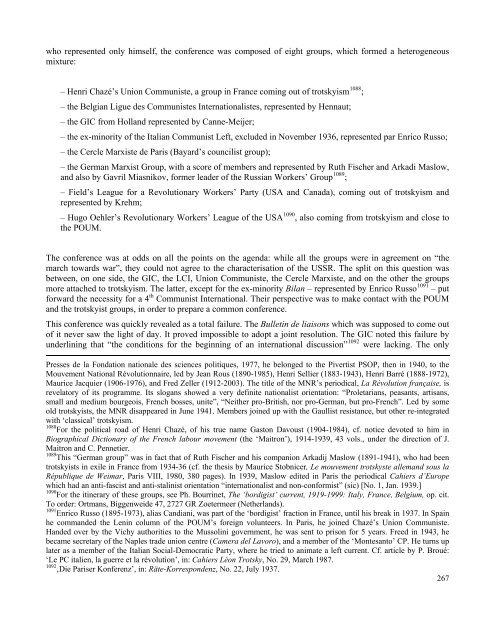The German-Dutch Communist Left - Libcom
The German-Dutch Communist Left - Libcom
The German-Dutch Communist Left - Libcom
Create successful ePaper yourself
Turn your PDF publications into a flip-book with our unique Google optimized e-Paper software.
who represented only himself, the conference was composed of eight groups, which formed a heterogeneous<br />
mixture:<br />
– Henri Chazé’s Union <strong>Communist</strong>e, a group in France coming out of trotskyism 1088 ;<br />
– the Belgian Ligue des <strong>Communist</strong>es Internationalistes, represented by Hennaut;<br />
– the GIC from Holland represented by Canne-Meijer;<br />
– the ex-minority of the Italian <strong>Communist</strong> <strong>Left</strong>, excluded in November 1936, represented par Enrico Russo;<br />
– the Cercle Marxiste de Paris (Bayard’s councilist group);<br />
– the <strong>German</strong> Marxist Group, with a score of members and represented by Ruth Fischer and Arkadi Maslow,<br />
and also by Gavril Miasnikov, former leader of the Russian Workers’ Group 1089 ;<br />
– Field’s League for a Revolutionary Workers’ Party (USA and Canada), coming out of trotskyism and<br />
represented by Krehm;<br />
– Hugo Oehler’s Revolutionary Workers’ League of the USA 1090 , also coming from trotskyism and close to<br />
the POUM.<br />
<strong>The</strong> conference was at odds on all the points on the agenda: while all the groups were in agreement on “the<br />
march towards war”, they could not agree to the characterisation of the USSR. <strong>The</strong> split on this question was<br />
between, on one side, the GIC, the LCI, Union <strong>Communist</strong>e, the Cercle Marxiste, and on the other the groups<br />
more attached to trotskyism. <strong>The</strong> latter, except for the ex-minority Bilan – represented by Enrico Russo 1091 – put<br />
forward the necessity for a 4 th <strong>Communist</strong> International. <strong>The</strong>ir perspective was to make contact with the POUM<br />
and the trotskyist groups, in order to prepare a common conference.<br />
This conference was quickly revealed as a total failure. <strong>The</strong> Bulletin de liaisons which was supposed to come out<br />
of it never saw the light of day. It proved impossible to adopt a joint resolution. <strong>The</strong> GIC noted this failure by<br />
underlining that “the conditions for the beginning of an international discussion” 1092 were lacking. <strong>The</strong> only<br />
Presses de la Fondation nationale des sciences politiques, 1977, he belonged to the Pivertist PSOP, then in 1940, to the<br />
Mouvement National Révolutionnaire, led by Jean Rous (1890-1985), Henri Sellier (1883-1943), Henri Barré (1888-1972),<br />
Maurice Jacquier (1906-1976), and Fred Zeller (1912-2003). <strong>The</strong> title of the MNR’s periodical, La Révolution française, is<br />
revelatory of its programme. Its slogans showed a very definite nationalist orientation: “Proletarians, peasants, artisans,<br />
small and medium bourgeois, French bosses, unite”, “Neither pro-British, nor pro-<strong>German</strong>, but pro-French”. Led by some<br />
old trotskyists, the MNR disappeared in June 1941. Members joined up with the Gaullist resistance, but other re-integrated<br />
with ‘classical’ trotskyism.<br />
1088 For the political road of Henri Chazé, of his true name Gaston Davoust (1904-1984), cf. notice devoted to him in<br />
Biographical Dictionary of the French labour movement (the ‘Maitron’), 1914-1939, 43 vols., under the direction of J.<br />
Maitron and C. Pennetier.<br />
1089 This “<strong>German</strong> group” was in fact that of Ruth Fischer and his companion Arkadij Maslow (1891-1941), who had been<br />
trotskyists in exile in France from 1934-36 (cf. the thesis by Maurice Stobnicer, Le mouvement trotskyste allemand sous la<br />
République de Weimar, Paris VIII, 1980, 380 pages). In 1939, Maslow edited in Paris the periodical Cahiers d’Europe<br />
which had an anti-fascist and anti-stalinist orientation “internationalist and non-conformist” (sic) [No. 1, Jan. 1939.]<br />
1090 For the itinerary of these groups, see Ph. Bourrinet, <strong>The</strong> ‘bordigist’ current, 1919-1999: Italy, France, Belgium, op. cit.<br />
To order: Ortmans, Biggenweide 47, 2727 GR Zoetermeer (Netherlands).<br />
1091 Enrico Russo (1895-1973), alias Candiani, was part of the ‘bordigist’ fraction in France, until his break in 1937. In Spain<br />
he commanded the Lenin column of the POUM’s foreign volunteers. In Paris, he joined Chazé’s Union <strong>Communist</strong>e.<br />
Handed over by the Vichy authorities to the Mussolini government, he was sent to prison for 5 years. Freed in 1943, he<br />
became secretary of the Naples trade union centre (Camera del Lavoro), and a member of the ‘Montesanto’ CP. He turns up<br />
later as a member of the Italian Social-Democratic Party, where he tried to animate a left current. Cf. article by P. Broué:<br />
‘Le PC italien, la guerre et la révolution’, in: Cahiers Léon Trotsky, No. 29, March 1987.<br />
1092 ‚Die Pariser Konferenz’, in: Räte-Korrespondenz, No. 22, July 1937.<br />
267
















